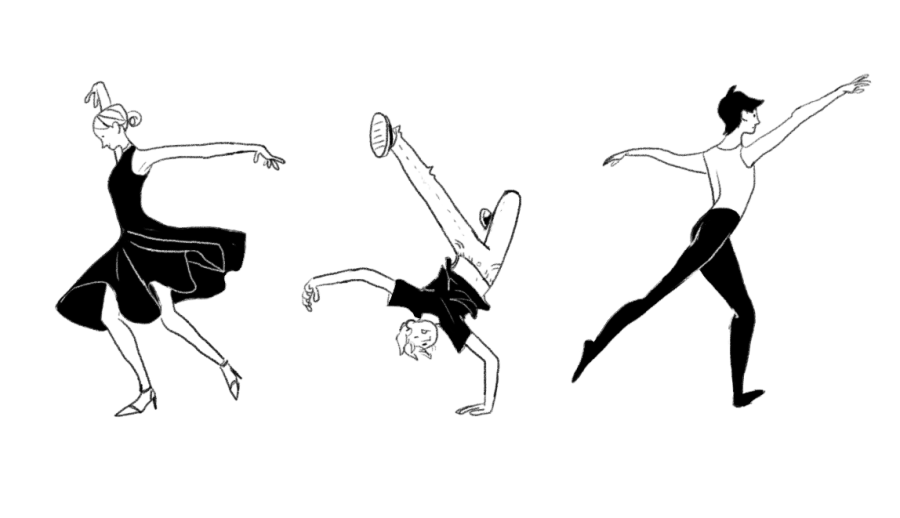Are dancers at the Urban School artists or athletes?
Illustration by Erika Gomi (’15)
Dancers in the Urban Community participate in various types of dance outside of school.
How do we define an athlete? Most never question the athleticism behind common sports like basketball, soccer, or cross country. But dancers seem to be isolated in a realm of their own.
Since not all dancers pursue dance competitively, it can be difficult to label dance as a sport. Martin Austin(‘16), who is part of the Dance Jam at Oberlin Dance Collective (ODC) remarks, “a lot of competition dancing isn’t very artistic.”
For dancers like Austin, the experience is more focused around artistry, teamwork and personal physical improvement rather than competition. Dance seems to fit under both the categories of arts and sports.
“It’s so athletic and beautiful at the same time,” explained Cassia Harrison (‘16), a dancer at Dance Mission.
Regardless of whether a dancer competes or even performs, certain types of dance require a tremendous amount of stamina and an array of physical and mental skills in classes and training.
Joe Skiffer (Urban Athletic Director) and Kali Heys (Urban Assistant Athletic Director) recognize the athleticism of dance, and allow several Urban students, like myself, to receive Physical Activity (PA) credit for dance outside of school.
Most students who request PA credit for dance “are pretty involved in dancing,”said Skiffer. “It’s not just something they do as a hobby. It’s more of a passion.”
Many dancers consider dance a central aspect of their identity. They often begin taking classes at a young age and proceed to expose themselves to different styles of dance.
“Modern, jazz, Afro Peruvian, hip-hop, ribbon dancing … belly dance, hip-hop, zumba, (and) samba,” are some of the numerous genres of dance that Izzy Garcia (‘15) has experienced thus far.
The ability to alter the rhythm and movements of one’s body to fit various styles demonstrates the physical and athletic versatility required of a well-rounded dancer.
None of these Urban student dancers have played an additional sport in high school. “I’ve never really had an affinity for sports,” said Austin.
This is also partly due to the fact that dance can be a huge time commitment. “I go there everyday after school for like three and a half hours … it’s hard to balance with school but it’s really enjoyable,” explained Eleanor James (‘16), who dances with Austin at ODC.
In addition to the tremendous time commitment, dance provides a great deal of physical activity, requiring the dancer to engage their muscles and develop overall strength. “I know dance takes a huge amount of flexibility, strength and balance … and lots of discipline,” said Heys. Depending on the skill level, dance can be “as strenuous as any sport we may offer” at Urban, stated Skiffer.
Urban math teacher, Laura Hawkins, who has been taking hip-hop classes regularly for the past several years, said, “I definitely do it for fitness.” Hawkins, who has experience playing basketball, explains that at times, certain aspects of dance class remind her of basketball skills.
“Performances are essentially just like games,” added Garcia. Just as playing a team sport requires dedication and awareness of others, dancing in a group requires a similar type of collaboration.
Whether or not the athletic community settles on dance being an official sport, it can certainly be classified as both a physical activity and an artistic practice.


